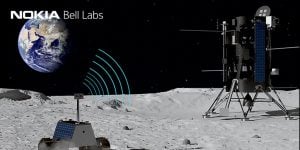
After being selected by NASA a week ago to be a partner involved in the Artemis operation, Nokia has unveiled further details on the role they will be playing, specifically being charged to deploy a cellular network on the Moon. Nokia’s proposal is to unleash the first ever LTE/4G communications system on the Moon/in space by “late 2022.” This proposal is backed by the belief that these systems could support lunar surface communications by making communication more reliable with increased speeds at greater distances.
Artemis’ long term vision is to lay the blueprint towards one day being able to have sustainable human presence on the Moon. In doing their part in making this dream come to reality one day, Nokia states “The network will provide critical communication capabilities for many different data transmission applications, including vital command and control functions, remote control of lunar rovers, real-time navigation and streaming of high definition video. These communication applications are all vital to long-term human presence on the lunar surface.” Nokia’s statement goes on to mention “Nokia’s LTE network – the precursor to 5G – is ideally suited for providing wireless connectivity for any activity that astronauts need to carry out, enabling voice and video communications capabilities, telemetry and biometric data exchange, and deployment and control of robotic and sensor payloads.”
With the original announcement made last week in accordance with NASA’s “tipping point” solicitation for commercial involvement, the U.S. Space Agency went about choosing 14 American based companies as partners in order to “develop a range of technologies that will help forge a path to sustainable Artemis operations on the Moon by the end of the decade.”
As claimed by NASA Administrator Jim Bridenstine “NASA’s significant investment in innovative technology demonstrations, led by small and large U.S. businesses across nine states, will expand what is possible in space and on the lunar surface.” Furthermore, Bridenstine concludes in stating “Together, NASA and industry are building up an array of mission-ready capabilities to support a sustainable presence on the Moon and future human missions to Mars.”
With Nokia’s contract set to value at $14.1 million, Nokia claims that their communications system have been carefully crafted to withstand the adverse conditions of the launch/lunar landing as well as space itself. The cellular network also promises to be able to meet the very stringent size, power, and weight constraints of space payloads in an incredibly compact manner. Consisting of an LTE Base Station with an integrated Evolved Packet Core (EPC) functionalities, LTE user equipment, RF antennas, as well as high-reliability operations and maintenance (O&M) control software, Nokia’s lunar network is primed for the task of delivering high speed communications on the Moon.
Why We Are One
For over 40 years, IBS Electronics Group has provided a broad range of integrated supply chain and electronicsmanufacturing solutions tailored specific to our customer's operations. As your one source for the industry’s top brands all in one place, our engineers specialize in reducing supply chain complexity and are here to provide you with dedicated support from prototype to production.




.png)


.png?resizemode=force&maxsidesize=96)